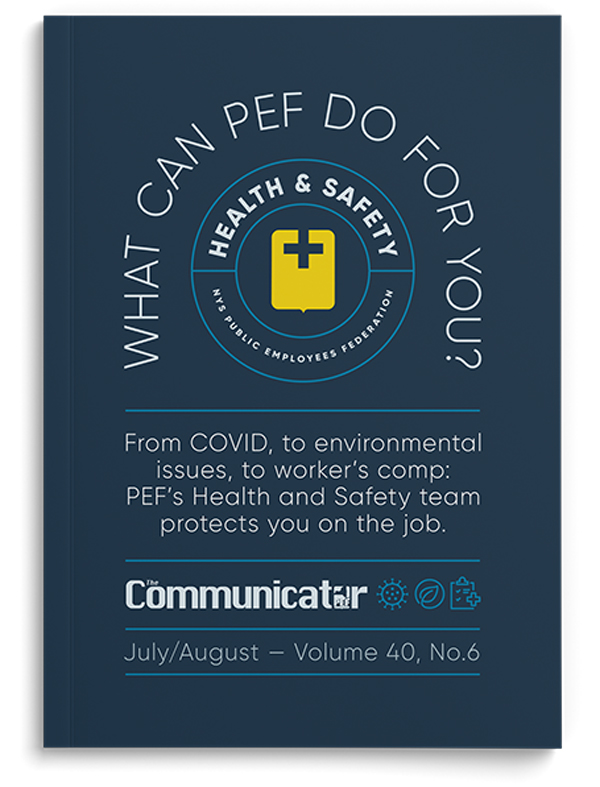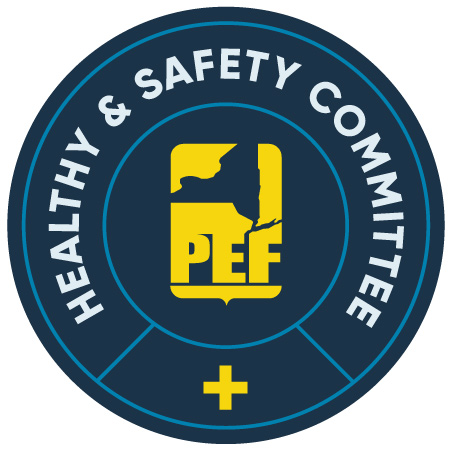 July 15, 2022 — The PEF Health and Safety Department hit the ground running in 2020 when COVID-19 began its sweep across the world – fighting for on-the-job protections, securing PPE, and creating in-depth toolkits, fact sheets, and resources that were picked up nationally, all while helping members navigate the whirlwind of workplace safety issues surrounding a new, deadly virus.
July 15, 2022 — The PEF Health and Safety Department hit the ground running in 2020 when COVID-19 began its sweep across the world – fighting for on-the-job protections, securing PPE, and creating in-depth toolkits, fact sheets, and resources that were picked up nationally, all while helping members navigate the whirlwind of workplace safety issues surrounding a new, deadly virus.
With a large portion of state employees in essential job titles, the Health and Safety Department was contacted by members exposed to the virus at work. Health and Safety Specialists worked directly with thousands of members to ensure they had the protections they needed and valuable information on workers’ compensation and contractual benefits.
Statewide Health and Safety Committees also tracked COVID-19 exposure trends to put in place critical control measures to mitigate potential on-the-job exposures. This included working directly with state agencies on Return-to-Work programs, pandemic plans, and often weekly meetings with State and Federal agencies and PEF Health and Safety Committees.
Department staff are leaders in health and safety
PEF’s Health and Safety Department goes beyond responding to health and safety at state worksites – they also participate in statewide and national dialogues relating to health and safety in the workplace, influencing health and safety policy.
“We work with a broad coalition of national unions on federal legislation and new OSHA standards, and we continue to work on major initiatives for issues such as workplace violence,” Health and Safety Director Geraldine Stella said. “We are also working with the PEF Legislative Department on developing bills to combat bullying and protect members in the aftermath of Less Is More and HALT legislation.
“We also meet with the state at two executive-level committees each year, along with other key state agencies, on health and safety issues with statewide impact, and on workers’ compensation,” she said.
Department staff have testified at federal committees on workplace violence, COVID and other safety issues. They continue to stay informed and involved in health and safety in the workplace across all levels of government.
Campaign to get members involved
 COVID isn’t over, but as the dust settles, health and safety issues — from ergonomics to environmental exposures, to workers’ compensation, to workplace violence, and more – are beginning to reemerge through the pandemic panic.
COVID isn’t over, but as the dust settles, health and safety issues — from ergonomics to environmental exposures, to workers’ compensation, to workplace violence, and more – are beginning to reemerge through the pandemic panic.
That’s when Health and Safety Committees shine.
“All the things pushed aside by COVID, the floodgates are opening,” said Stella. “As COVID goes down, we are fighting to get our Health and Safety Committees back up and running to address these issues.”
The health and safety field encompasses more than just the potential for illness or injury from diseases like COVID or accidents like a slip and fall – educating members on what to look for and how to advocate in their workplace is a primary function of the PEF Health and Safety Department.
“We are trying to recruit new people,” Stella said. “We want to build and solidify statewide, agency-level and local-level Health and Safety Committees and are making a concerted effort to reengage and refocus.”
Under Article 18 of the PEF contract, New York state and PEF must establish agency and local Health and Safety Committees; schedule meetings at least quarterly; refer matters not resolved locally to the agency level; and refer matters not resolved at the agency level to the statewide level for review.
“We are entitled to one Health and Safety Committee for each worksite,” explained Health and Safety Specialist Veronica Foley. While that might work for facilities, some agencies covering multiple locations or smaller offices with similar needs, like the State Education Department and the Department of Labor, may benefit from regional committees instead.
PEF offers education on advocating for your workplace
The Health and Safety Department offers myriad training opportunities for rank-and-file members to get involved and help ensure their workplace is safe.
Every other year, the department holds a three-day conference to bring together committee chairs and experts, allowing members to network and learn about different occupational safety and health issues.
Since the pandemic derailed meetings in 2020, the department hopes to bring back the conference in the Spring of 2023, as well as revitalize other recruitment efforts, such as the Plus One Program, where leaders can bring along a “plus one” who is interested in health and safety, immersing the recruit in information sessions and networking opportunities. Members involved in the Plus One Program have made great strides within the union to become health and safety advocates, committee members, local chairs and sometimes even statewide chairs for their agency committees.
The Health and Safety Department also offers training programs with mutual benefits for the State and the PEF membership. For example, state employees have significant rates of repetitive strain injuries and poor ergonomic set up. The Health and Safety Department has a nationally recognized ergonomics program which offers a full day course for state agencies to train a peer group of employees on how to conduct an ergonomic assessment of workstations and properly set them up for employees to work more comfortably and with less injury. Repetitive strain injuries can be very costly to the state, but this program has proven to reduce workplace injuries due to poor ergonomics. “The ergonomics program is also a great way for members to get involved in the union and collaborate with their agency,” said Health and Safety Specialist Paige Saakyan, who leads the PEF Ergonomics Program.
Member involvement is vital to the success of health and safety programs. Without those boots on the ground across the agencies and state, issues wouldn’t be brought to the attention of local PEF representatives.
“Sometimes one person’s issue leads to broader discussions,” said Stella.
Case in point: a new disinfectant sickens an employee, so they bring it to the attention of their local PEF steward. That begins a narrative and brings about a solution that may benefit others who were sickened in other areas or locations but didn’t say anything.
“In the fight for safe workplaces, nobody does it better than the PEF Health and Safety staff. But we can’t be everywhere,” Stella said. “We try to teach the committees how to advocate so they are empowered to do it continuously. We want to teach them to fish!”
Whether it’s reporting an issue or serving on a committee, PEF urges members to become advocates for themselves and their coworkers. Health and Safety Specialist Shawn Bobb summed it up this way: “PEF is a member- driven union – they are the ones who make things happen.”
“We are working with PEF Organizing and Field Services to re-build our committee structure,” Stella said. “COVID destroyed it. People retired or left state employment and the local committee structure fell apart. We need to get back to the stronger structures we used to have.”
“We have to make sure we have active Health and Safety Committees,” said Bobb. “We have to have volunteers participate, identify advocates who want to be involved, and get them training. Even if they can’t be on a committee, they can be involved in making their workplaces safer.”
If you’re interested in getting involved, joining a Health and Safety Committee, or to get training, reach out to your local PEF leader, Steward, or PEF Field Representative, or contact the PEF Health and Safety Department at HealthAndSafety@pef.org or 800-342-4306 ext. 254.

